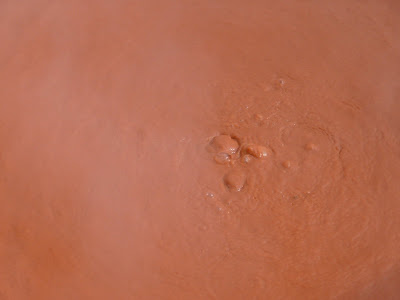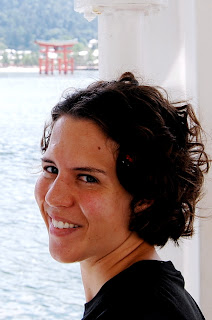
The boiling waters of Beppu.
Valentine's Day this year was red hot. Positively steaming.

We headed south to Kyushu, Japan's southernmost main island, to the famous little town of Beppu. Beppu is famous for a couple things: 1) onsen, also known as hot spring public baths, and 2) its "burning hells."
Beppu is built upon numerous geothermal hot springs, which make the town a pretty steamy place. There are numerous hot springs for bathing in, and then there are the hot springs too hot to handle — those are the burning hells, known in Japanese as jigoku. They're just for looking, not bathing.
Down the mountainside in one area of the city, eight of these hells bubble to the surface in a variety of colors. There's plenty of tourist kitsch surrounding these wonders of nature, but it was still worth the visit. Here's what we saw.
First up: Umi Jigoku (Sea Hell)


Mainly a lot of steaming rocks. Penned up nearby were an unhappy hippo and icky looking monkey. Also a very sad elephant. And some flamingos that were attacking each other. Nothing like random zoo animals to make an instant kiddie attraction.



Beppu is built upon numerous geothermal hot springs, which make the town a pretty steamy place. There are numerous hot springs for bathing in, and then there are the hot springs too hot to handle — those are the burning hells, known in Japanese as jigoku. They're just for looking, not bathing.
Down the mountainside in one area of the city, eight of these hells bubble to the surface in a variety of colors. There's plenty of tourist kitsch surrounding these wonders of nature, but it was still worth the visit. Here's what we saw.
First up: Umi Jigoku (Sea Hell)
This pond of boiling turquoise water is about 656 feet deep (nearly 220 yards — think of that, well over two football fields in depth!). It was formed 1,200 years ago after a volcanic explosion.
A great deal of stinky steam poured off these hot springs. It smelled like sulfur. Not so pleasant but I didn't really mind.
As you can see, there's a basket of eggs boiling in the water. Perhaps the sulfuric water increases the eggy intensity? These hot spring boiled eggs are considered a specialty of the area, and they were sold in road side stands and even the train station.

Hot springs boiled eggs for 50 yen a piece (55 cents). I think they're covered in salt.
In sharp contrast to the Sea Hell was the nearby red hot spring. Not big enough to be one of the official eight jigoku, but pretty cool (and equally stinky).
Next up: Oniishibozu Jigoku. A.k.a. Oniishi Shaven Head Hell. So named because the hot gray mud that bubbles to the surface here resembles a bald monk's head, perfectly round and smooth and shiny.




These were cool. I stared for a long time. The mud all around the bubbles hardens into what looks like a ringed tree trunk made out of clay.
Number 3: Yama Jigoku (Mountain Hell)

Mainly a lot of steaming rocks. Penned up nearby were an unhappy hippo and icky looking monkey. Also a very sad elephant. And some flamingos that were attacking each other. Nothing like random zoo animals to make an instant kiddie attraction.
4.) Kamado Jigoku (Oven Hell)
If the unhappy hippo didn't cast enough of a touristy haze over the place, the next hell stepped it up a notch with a corny demon statue.

Kids not impressed by the unhappy hippo? Don't despair, they should really love this character and his giant...

BALLS!
Amusingly, the brochure left out those gems with a shot expertly photographed from the right angle.
The Oven Hell includes a large blue pond that changes color somewhat depending on the time of year, and some smaller ones filled with bubbling red water and brown mud.
Fifth up: Oniyama Jigoku (Demon Mountain Hell)
This Hell bubbled violently with waves splashing everywhere. Signs informed us that the force of the steam rising off this hell was strong enough to pull one and a half train cars, and indeed it was too steamy to photograph.
Supposedly all that steam creates an ideal environment for breeding crocodiles. There were dozens of crocodiles and alligators penned up nearby.
We even saw one with moss growing on its back.
That can't be good.
Number 6: Shiraike Jigoku, the White Pond Hell
According to the sign, the water is clear when it bubbles from the ground but over time it takes on a creamy white-blue hue. There were some fish tanks in a building next to the pond. They contained piranhas.
The last two hells were 1.5 miles away. There's a bus to take you there, but the next one wasn't due to arrive for another 40 minutes or so, so we decided to hoof it. Probably not the smartest decision we've ever made, as the sidewalk disappeared after the first five minutes. But, at least we got some nice views over the city and the ocean as we walked.
It was neat to see the spouts of steam dotting the city.
After a nice walk in close proximity to traffic we came to Number 7: Chinoike Jigoku the Blood Pond Hell, which is the oldest natural jigoku in Japan. It looked pretty much like the first red hot spring we saw, just bigger.
The red color comes from the red clay beneath, which dissolves in the water. The water is used as dye and is supposedly "good for skin diseases," though the sign didn't specify if that was for curing or causing them.
Last on the list was Tatsumaki Jigoku, the Water Spout Hell, an intermittent spring that shoots water every 25 minutes or so. It apparently spouts up to 65 feet, though the rocks built up over the top blocked the spray.

I could have done without all the hokey tourist melodrama — crocodiles! piranhas! blood! demons! — but I guess that's just par for the course at a site like this. I might have appreciated the lighthearted nature of it a little more if the animals weren't treated so shabbily. Still, the hot springs were intriguing. Worth the visit.
The evening after seeing the jigoku, Joe and I went to visit a really nice onsen at the Suginoi Palace. We had wanted to stay at this place, but at a minimum of $200 per night per person, it was obviously too expensive, so we opted to stay in a cheap business hotel instead and just visit its onsen for 1,000 yen ($11).
I was nervous about going. You can imagine that bathing in front of a bunch of other Japanese ladies didn't exactly fill my heart with feelings of calm and serenity. Especially not when I'd be the lone naked foreigner. Actually though, it turned out to be not a big deal at all. Here's how it worked.
The onsen provided me with a towel and wash cloth. After stripping down and stashing my belongings in a locker room, I entered the showering area where everybody was taking a shower seated on little plastic seats. There were partitions sectioning off each shower head. You're still in a big room with lots of other ladies showering, but it's sectioned off enough that you feel like you have your own little area. The onsen provided face wash, shampoo and soap, which even had a lovely limey scent since the Beppu area is famous for a kind of lime.
After showering, it's time to soak in the bath. Essentially it is like a giant swimming pool that is perhaps 3 feet deep and steaming hot. I tied my hair up so it wouldn't drag in the water (a faux pas) and set my washcloth on the ledge of the bath because you're not supposed to bring it in the bath with you and I didn't know where else to put it (by the time I got out, it had disappeared).
You can opt to bathe indoors or outdoors. I headed outside and wasted no time getting in as it was probably around 35 or 40 degrees outside. The onsen was designed with five tiers, with water from the higher steps pouring down to the lower steps. The Suginoi is situated high on the hillside overlooking the city, which made for a beautiful night view while we were in the bath.

Like this only at night with all the city lights. Photo of Suginoi stolen from the Net.
I hadn't expected to stay in the bath very long. I'd tried the public bath in our business hotel the previous evening and it was so hot that I got out after 10 minutes feeling a bit lightheaded. This was better though. Whenever I started to feel too hot, I just hoisted myself up onto the ledge and sat in the brisk winter air for a few minutes until I'd cooled down enough to get back in. Steam rolled off the smooth surface of the bath. The water came up to my chin.
At the front of the bath, on the lowest tier, the tiles were formed into reclining chairs with a wooden headrest. After a while, I snagged one of those and laid there for a very long time feeling so relaxed I was kind of half asleep. All the things that irritated me about Japan just melted away. Turns out bathing with a bunch of Japanese ladies filled me with calm and serenity after all.







